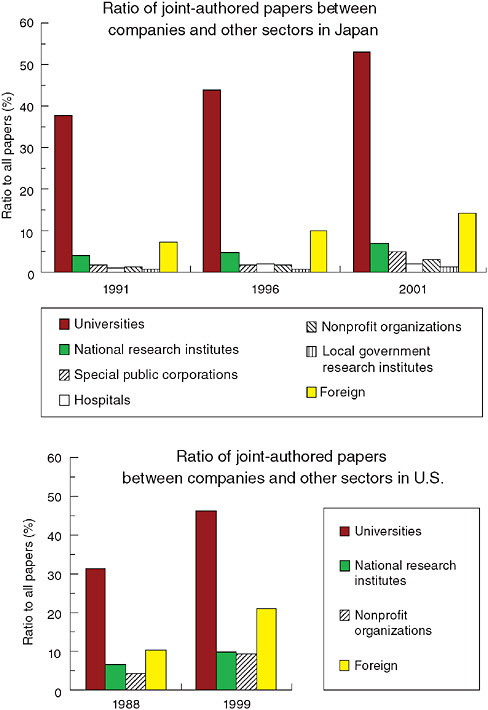University-Industry Partnerships in Japan
Masayuki Kondo
Yokohama National University and National Institute of Science and Technology Policy (NISTEP)
UNIVERSITY-INDUSTRY PARTNERSHIPS IN A NATIONAL INNOVATION SYSTEM
A national innovation system contains three knowledge-creating sectors: universities, public research institutes, and industry. Universities play an important role in basic research, and industry plays an important role in development. The division of labor among these sectors is clearer in the United States than in Japan. In the United States, universities conduct 62.0 percent of national basic research, whereas in Japan they conduct only 46.5 percent of it (Figure 1). Japanese public research institutes are important in basic research, whereas their U.S. counterparts are important in applied research.
Among these three sectors, only industry delivers new products and new processes to the market. Therefore, the question for policymakers and industry managers is how a nation can best use the science and technology capability of the two knowledge creating sectors, universities and public research institutes, to augment the science and technology capability of the industry sector for industrial innovation (Figure 2). In this chapter, we focus on universities.
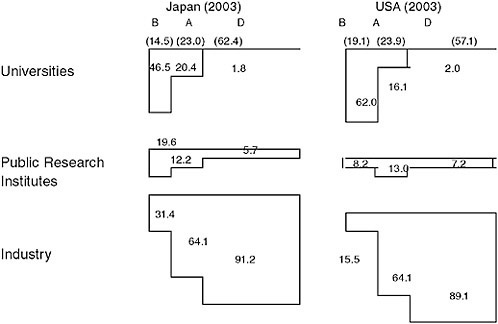
FIGURE 1 Role charts.
NOTE: Unit is percent.
SOURCE: Devised using data from Statistics Bureau, Report on the Survey of Research and Development 2004, (Japanese), Japan Statistical Association, 2004; and Organization of Economic Cooperation and Development, Research and Development Statistics, 2004 Edition, Paris: Organization for Economic Cooperation and Development, 2004.
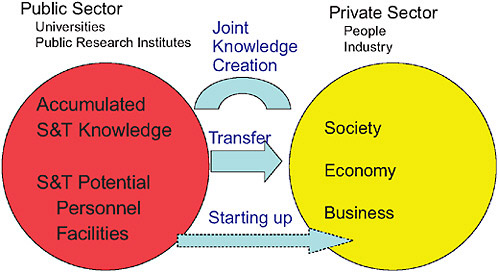
FIGURE 2 Question: How can we utilize S&T for society, economy, and business in a national innovation system?
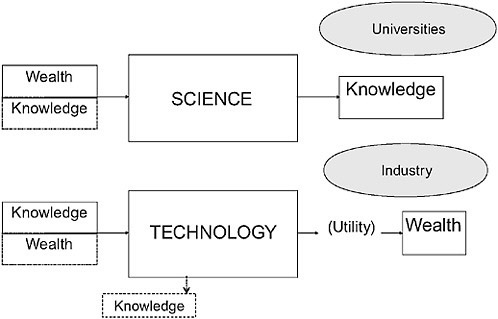
FIGURE 3 Science vs. technology.
Universities can contribute to industry innovation in three ways: knowledge transfer from universities to industry1; joint creation of knowledge by university and industry researchers; and formation of a new company based on university knowledge.
The involvement of the industry sector is essential to using university knowledge in the economy and society. Universities basically exist in the science in which knowledge is created using wealth (Figure 3). Industry lives in technology culture in which knowledge, including scientific knowledge is used to create utility.
These days, science and technology are becoming closer. According to Stokes (1997), research is categorized into three types (Figure 4): pure basic research (Bohr’s quadrant), pure applied research (Edison’s quadrant), and use-inspired pure basic research (Pasteur’s quadrant). Pasteur-type research has been growing in importance because innovation has become more science-based. Thus, the importance of scientific knowledge created in the university sector and of university-industry partnership has grown.
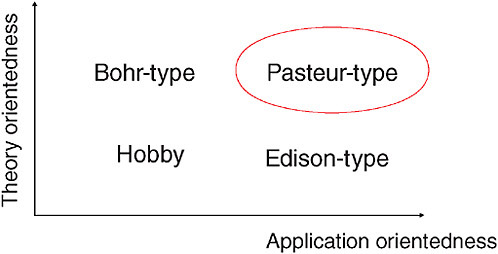
FIGURE 4 Science-based technology.
SOURCE: Modified from diagram of Donald E. Stokes, Pasteur’s Quadrant: Basic Science and Technological Innovation, Washington, D.C.: Brookings Institution Press, 1997.
HISTORICAL VIEWS OF UNIVERSITY-INDUSTRY PARTNERSHIPS IN JAPAN
Though university-industry partnerships were not active in the 1960s and 1970s—in part because of student political movements and campus disruptions, there is a long-standing tradition of cooperation in Japan. In this section two cases of good university-industry relation are discussed: the establishment of the world’s first Department of Engineering at the University of Tokyo and the work of the Institute of Physical and Chemical Research (RIKEN) in leading a large industrial group before World War II.
Department of Engineering, Tokyo University
At the start of Japan’s modernization, Japan imported technologies from the West. In addition to importing machines and documents, the government hired many foreigners. These engineers were needed to construct infrastructure, such as railways and telegraph line networks, and to build and operate modern factories. However, these foreigners, some of whom earned more than did government ministers were too costly to hire for a long time.
The government decided to foster Japanese engineers to replace these foreigners. The government sent a certain number of young Japanese to study overseas and established an engineering school at home. The Imperial College of Engineering was established under the Ministry of Engineering, not the Ministry
of Education, in 1873, and became the College of Engineering of Imperial University (now the University of Tokyo) in 1886.
The curriculum of Imperial College of Engineering was designed by Dr. Henry Dyer from Scotland, who was the president of the college from 1873 to 1882. It combined theoretical studies and practices. The six-year course of study included two years of basics such as mathematics, two years of study of a branch of engineering such as mechanical engineering, and two years were dedicated to practice. Graduates from the College worked in the industry, government, and academia.
Thus, the engineering departments of Japanese universities were application-oriented from birth.
RIKEN (Institute of Physical and Chemical Research)
I am aware of only one research institute in the world formed an industrial concern and enabled it to be profitable and to support the institute itself2: the Institute of Physical and Chemical Research (RIKEN) of Japan, which created the RIKEN Industrial Group. Many companies belonged to this group, and some such as Ricoh, a maker of cameras and copiers, became very successful. Since many of principal researchers of RIKEN held joint appointments as university professors, RIKEN can be considered an example of university-industry partnership.
RIKEN was established in 1917 at the initial stage of Japan’s industrialization as the first full-scale national research institute with government support. The initiative to establish RIKEN started in 1913 when Dr. Jokichi Takamine, a scientist and millionaire living in the United States, pointed out the need for a National Science Research Institute. Prime Minister Ohkuma and influential business leader Baron Shibusawa were the key players in making this suggestion a reality.
RIKEN excelled in a wide range of R&D activities from basic research to commercial product development. At one extreme, it produced more than 3,700 research papers from 1922 to 1941, including 1,686 papers in Japanese and 1,072 papers in foreign languages. Moreover, the first two of Japan’s Nobel Prize winners, Dr. Yukawa and Dr. Tomonaga, did research on the structure of an atom at RIKEN. Another Nobel Prize Laureate, Dr. Fukui, was a researcher under Prof. Kita, who was also a researcher at RIKEN.
In addition, RIKEN developed new processes, such as new methods to produce vitamins, and new products such as piston rings, photosensitive papers, gas microanalyzers, and light and strong aluminum cookware called Alumite. RIKEN was granted 0.7 percent of all patents registered in Japan during the period from 1918 to 1944, and these patents became an important source of revenue.
TABLE 1 Revenue of RIKEN
|
Year |
1927 |
1939 |
1940 |
|||
|
Thousand Yen |
Percent |
Thousand Yen |
Percent |
Thousand Yen |
Percent |
|
|
R&D contract |
13 |
2.0 |
264 |
7.1 |
137 |
3.8 |
|
Patent royalty |
0 |
0.0 |
1,793 |
48.4 |
2,182 |
60.4 |
|
Production work |
206 |
31.2 |
53 |
1.4 |
44 |
1.2 |
|
Stock operation |
37 |
5.6 |
740 |
20.0 |
6 |
0.2 |
|
Rent |
6 |
0.9 |
1 |
0.0 |
1 |
0.0 |
|
Interests and dividends |
143 |
21.7 |
793 |
21.4 |
876 |
24.3 |
|
Subsidies |
250 |
37.9 |
0 |
0.0 |
0 |
0.0 |
|
Miscellaneous |
4 |
0.6 |
61 |
1.6 |
367 |
10.2 |
|
Total |
660 |
100.0 |
3,705 |
100.0 |
3,611 |
100.0 |
|
SOURCE: The author tabulated the data from Ken Saito, Research on a New Concern: RIKEN Industrial Group (Japanese), Jichosha, 1987. |
||||||
In the early days, RIKEN depended financially on the government subsidies despite the efforts to create revenue from R&D. Even in 1927, eleven years after its founding, the top revenue category was subsidies, which occupied more than a third of total revenue (Table 1). Only 2 percent of the revenue came from contract R&D, and the revenue from production work accounted for 31 percent. Production work meant crafting some apparatus for outside needs or pilot production of products developed by RIKEN. Interest and dividends (mostly from subsidiaries as in 1939?) occupied more than a fifth of the revenue. There was no patent royalty revenue yet in that year. It first appeared in the following year, 1928.
The revenue structure after successful commercialization of RIKEN inventions was quite different from that of the early days. In 1939, when the number of companies in the group was largest and the revenue of RIKEN was at a maximum, no subsidies were received. Nearly half of the revenue was from patent royalties from 46 companies; and the revenue from R&D was a significant 7.1 percent. The interests and dividends revenue and the revenue from stock operation were also large, accounting for 21.4 percent and 20 percent of the total revenue respectively. The royalty, the dividends, and the revenue from stock operation were related mostly to the group companies, because most (98.6 percent) of the revenue came from them.3 In 1940, when the royalty revenue was the largest, the revenue from patent royalty from 54 companies occupied 60.4 percent of the total revenue. In other words, the majority of RIKEN’s revenue was created from intellectual capital.
RIKEN was also entrepreneurial in spinning off companies and was successful in commercializing its products through these companies. The RIKEN Industrial
Group was fairly large and successful as a conglomerate, though its life was short. The Group consisted of 63 companies at maximum. It started in 1927 when the first company was established and practically ended in 1941 when major member companies were merged to cope with financial difficulties, due to the War.
The RIKEN Industrial Group excelled in managing the transfer of technology from RIKEN to the group companies. Research was carried out in RIKEN; engineering development was done in RIKEN or Physical and Chemical Industrial Corporation, a group company specialized in engineering development; and production was carried out in the other group companies.
The success of RIKEN and the RIKEN Industrial Group depended heavily on Director Ohkohchi.4 He managed RIKEN as “a free paradise for researchers,”5 albeit with rigorous evaluation. He created two new management philosophies—science capital industry and intellectual management—and two new production management methods—combinatory management and rural industrialization.6
In science capital industry the dynamic forces of R&D and innovation create new industries with new products and production methods, and scientific knowledge plays the role of capital in capitalism. Typical Japanese capitalists at that time entered the business world with capital and made licensing agreement with overseas companies and bought equipment from overseas at high prices, whereas RIKEN entered the business world with its intellectual capital and entrepreneurship.
With intellectual management, RIKEN claimed that it could provide intellectual assistance to the group companies from various perspectives since RIKEN performed integrated research of physics, chemistry, electrical engineering, and mechanical engineering. This would lower the prices of products and improve their qualities at the same time. It would also increase the wage of workers and enhance their welfare. For example, in a chemical plant chemical engineers invented new processes and played a major role in quality improvement, while mechanical engineers designed and built actual plants and improved equipment to raise productivity.
Combinatory management seeks to create synergy by linking factories in a geographical area. One factory could use byproducts such as waste heat from other factories in this setting. If an output of one factory is an input of another factory, these two factories could be connected directly by pipes to reduce transportation costs. The combination of inter-related industries could be easily thought of
because RIKEN performed a wide range of research and developed a wide rage of products and processes. This production management method was applied to the production of magnesium for airplane production. Combinatory management was invented to increase production efficiency of small-scale plants that could not enjoy the economy of scale to compete with imported products.
Rural industrialization seeks efficiency through division of labor in the machinery industry. This method made use of unskilled low-wage labor in rural areas by simplifying skills required for producing mechanical products through replacing versatile machines with specialized single-use machines. RIKEN could break down a complex machining process into simple processes and design and produce single-use machines. Rural industrialization realized low-cost production and rural industrialization.
RIKEN and its Industrial Group did not last long. They were dissolved by the occupying allied forces in 1948 after the end of the World War II. An independent administrative agency whose name is RIKEN still exists, but its industrial group does not.
RECENT UNIVERSITY-INDUSTRY PARTNERSHIPS IN JAPAN
Forms of University-Industry Partnership
As described above, there are three ways to utilize the science and technology capability of the university sector for industrial innovation: jointly creating knowledge between university researchers and industry researchers, transferring university knowledge to the industry, and starting up new companies based on university knowledge.7 For each way there are some forms of university-industry partnership. For joint knowledge creation, a representative form is joint research. Contract research also has some aspects of joint knowledge creation since research themes are given from the industry at the beginning of research and some feedbacks are provided during the research. Academic donation could be a weak form of joint knowledge creation. University researchers and company researchers exchange information and opinions through donation. Recently, a new form of partnership has appeared: the comprehensive collaboration agreement. This agreement covers a wide range of collaboration such as information exchanges, personnel exchanges, joint research grant application, joint research, and joint human resource development. This agreement can be made between one university and one company, between one university and multiple companies, and between multiple universities and multiple companies.
For knowledge transfer through diffusion the options include journal papers and books, the Internet, and conference presentations. More targeted forms of knowledge transfer include consulting by professors and patent licensing.
Students can be good media for knowledge transfer when graduated students find jobs in the industry, current students find internships, and when a company sends its employees to study at a university.
For knowledge-based startups, academic spin-offs are created. They commercialize university research results for industrial innovation. In some cases, university knowledge is transferred through technology licensing or via other forms. In other cases, university knowledge is transferred through the involvement of university researchers or students in the management of startups.
As for university-industry partnerships, facility and equipment usage is another form of partnership. If the facilities are extremely expensive, as in the case of cyclotrons, this partnership is important. For small-and-medium-size companies, university facilities and equipment can be useful.
Policies to Promote University-Industry Partnerships in Japan
Though Japanese universities, especially engineering schools, have a pragmatic tradition, university-industry partnerships were not encouraged and were not active in the late 1960s and 1970s due to the student political movement and campus disturbances. However, the environment changed in the 1980s, and the government formulated and implemented various policies to promote university-industry partnerships.
For joint knowledge creation, the government established a formal scheme of joint research in 1983. In addition, the government helped establish Collaborative Research Centers in national universities beginning in 1987 (Figure 5). In 1999, the government began providing research grants to encourage university-industry joint research.
For knowledge transfer, the government started providing financial assistance to Technology Licensing Organizations (TLOs) in 1998. As of September 2005, there were 41 approved TLOs eligible for public assistance. In addition, the government started the University Intellectual Property Right (IPR) Management Center Program in 2003 to assist 34 universities to establish IPR management capability on campus.
For knowledge-based startups, the government established Venturing Business Laboratories (VBLs) in national universities in 1995. There were 45 VBLs as of March 2004. The policy aims at fostering young entrepreneurial researchers through commercialization research. In April 2000, to encourage university spinoffs the government relaxed the regulation that prevented national university professors from serving as board members of private companies. Further, beginning in 2001 the government started helping to construct incubators on campus in national universities. There were 23 incubators as of March 2004.
Drastic change occurred in April 2004, when the government changed national universities into national university agencies. Each national university agency has an independent legal status and can make its own management deci-
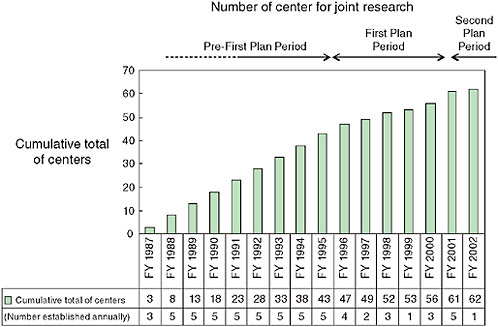
FIGURE 5 Joint Research Centers at National University.
SOURCE: Ministry of Education, Culture, Sports, Science and Technology—Japan (MEXT), Web site.
sions and make contracts with other parties. Its employees are not civil servants anymore.
Performances of University-Industry Partnership
As a result of these policy efforts, the amount of collaborative research increased, especially since the mid-1990s.8 In FY2003 more than 6,000 joint research projects were conducted between universities and industry according to NISTEP (2005) (Figure 6).9 Recently, small-and-medium-size enterprises, especially new technology-based firms, have become active in university-industry joint research.10 According to the studies conducted by Small and Medium Enterprise Agency, small-and-medium-size companies who had collaborated with

FIGURE 6 University-Industry Joint Research.
SOURCE: National Institute of Science and Technology Policy (NISTEP), Study for Evaluating the Achievements of the S&T Basic Plans in Japan—Highlights, (Japanese), NISTEP Report No. 83, 2005.
universities absorbed new knowledge and established new technologies11 and those who collaborated with universities and public research institutes showed higher growth rates of profits.12
The increased collaboration between universities and industry appeared in paper co-authoring. More than half the research papers written by company researchers were coauthored with university researchers in Japan in 2001 according to NISTEP (2004) (Figure 7). This co-authorship ratio was comparable to the ratio in the United States.
A more detailed case analysis of Yokohama National University (YNU) revealed that deepening and diversification were observed at the same time according to Sakamoto and Kondo (2004). For deepening, they found that the number of joint research projects per company was increasing, that the number of joint research projects with large budgets was increasing, and that local university-
industry joint research was increasing in terms of number and total budget. For diversification, they found that new types of companies, such as multinational companies and service industry companies, had started joint research with YNU recently, new faculty members were starting university-industry joint research, and the difference between the largest project budget and the smallest one was widening.
However, science linkage has been weak in Japan. The science linkage is measured as the number of research papers per registered patent using patents registered in the United States. The patents applied for by U.S. nationals had a strong science linkage compared to the patents applied for by Japanese nationals according to NISTEP (2004) (Figure 8).
In order to see the technology transfer, we examined the performance of the Japanese university sector from R&D investment to license income compared with the U.S. university sector. The R&D investment of the Japanese university sector was 3.3 trillion yen in 2002, whereas the U.S. university sector invested 5.4 trillion yen in 2002. The ration was 1:1.6 (Table 2). For patent applications, the ratio was 1:3.9, and for licensing contracts, the ratio was 7.0. However, when it comes to license income, the ratio was 1:264. This is partly due to the fact that the history of formal technology transfer from universities in the form of patent licensing in Japan is short.
Academic Spin-offs—From “Collaboration” to “Cross-over”
University-industry partnership has entered into a new stage in Japan, evolving from university-industry collaboration to “university-industry cross-over” (Figure 9).13 In this university-industry cross-over, universities and some faculty members become entrepreneurial and engage in commercial activities. Traditionally, these activities took place only in the industry sector. Now, universities or university members conduct these activities by crossing over the traditional boundary between universities and industry.
The academic spin-off activities in Japan increased beginning in 2000, when the regulation on national university professors to serve as board members of private companies was relaxed (Figure 10). In recent years, more than 150 academic spin-offs were established per year. Many of them were in high-tech areas. A quarter of them belonged to information and communication technology (ICT) and a fifth belonged to the life sciences as of August 2003. A recent trend shows that the largest number of academic spin-offs was established in the life sciences.
The number of newspaper articles on university spin-offs also increased (Figure 11) beginning in 2001. In 2002, one saw an article on university spin-offs almost every day. In 2004, one saw nearly two articles on university spin-offs per day.
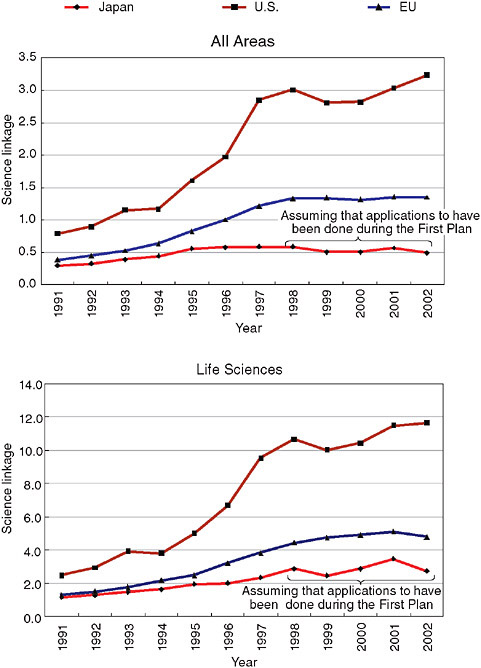
FIGURE 8 Science linkage in U.S. patents.
NOTE: “Science linkage” is the number of cited scientific papers in the U.S. patent examination reports per registered patent. It indicates a frequency of the use of scientific knowledge among patents.
SOURCE: National Institute of Science and Technology Policy (NISTEP), Study for Evaluating the Achievements of the S&T Basic Plans in Japan—FY2003 Highlights, (Japanese), NISTEP Report No. 74, 2004.
TABLE 2 University Licensing (Japan-U.S. Comparison)
|
|
Japan |
United States |
Ratio |
|
R&D |
3.3 trillion yen (in 2002) |
5.4 trillion yen (in 2002) |
1.6 |
|
Patent applications |
1,680 (in 2003) |
6,509 (in 2002) |
3.9 |
|
Licensing contracts |
531 (in 2003) |
3,739 (in 2002) |
7.0 |
|
License income |
0.55 billion yen (in 2003) |
145 billion yen (in 2002) |
264 |
|
cf. Academic spin-offs |
179 (in 2003) |
364 (in 2002) |
2.0 |
|
SOURCE: The author calculated and tabulated using the data of National Institute of Science and Technology Policy (NISTEP), Study for Evaluating the Achievements of the S&T Basic Plans in Japan—Highlights, (Japanese), NISTEP Report No. 83, 2005. |
|||
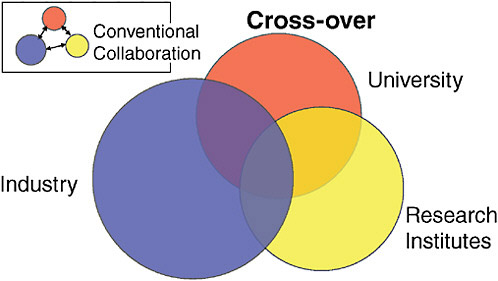
FIGURE 9 Cross-over among industry, universities, and public research institutes.
SOURCE: M. Kondo, “University Spin-offs in Japan,” Asia Pacific Tech Monitor, March-April 2004, pp. 37-43, Asian and Pacific Centre for Transfer of Technology, ESCAP, UN.
Nearly 70 percent of founders of spin-off companies were faculty members (Table 3). Among student founders, about half were doctoral students. This indicates that many of academic spin-offs are based on solid technologies.
The spin-off companies seem to occupy a middle ground between universities and industry. Only 16.1 percent of spin-off companies intend to become manufacturer (Table 4). Others intend to conduct R&D, collaborate with universities, sell technologies in one form or another, or ask other companies to manufacture their products.
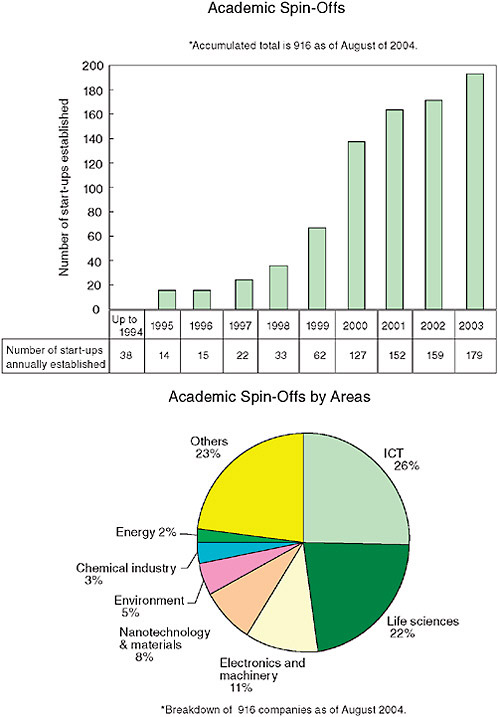
FIGURE 10 Academic spin-offs in Japan.
SOURCE: National Institute of Science and Technology Policy (NISTEP), Study for Evaluating the Achievements of the S&T Basic Plans in Japan—Highlights, (Japanese), NISTEP Report No. 83, 2005. Data calculated by NISTEP based on Tsukuba University and Yokohama National University, “University Spin-off Survey FY2004.”
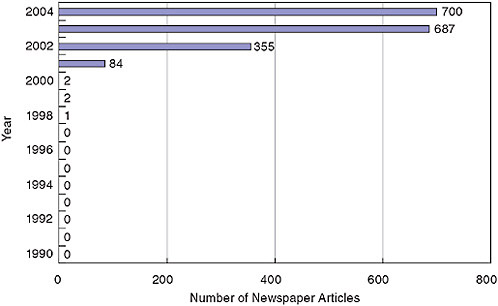
FIGURE 11 Newspaper articles on “university spin-offs” in Japan.
NOTE: The number of articles in four newspapers published by NIKKEI.
SOURCE: Author counted using NIKKEI TELECOM 21.
CONCLUSIONS
For healthy development of university-industry partnerships, some reservations need to be pointed out. First, a university needs to keep its identity. A university is responsible for higher education and for the advancement of human knowledge as well as for contribution to the society. This is a part of the reason why a university is largely financed by public funds and/or is favorably treated regarding taxation
Second, and more pragmatically, Japanese universities need to establish rules to avoid conflicts of interests at the working level.14 Student education should not be jeopardized by university-industry partnerships, and academic freedom needs to be guaranteed. In addition, insider transactions of equity shares should be avoided since universities and faculty members can now become equity shareholders of academic spin-offs.
Third, practices to handle research-tool patents in academic research need to be established. On the one hand, once universities become entrepreneurial and engage in commercial activities such as licensing, they also need to respect patent
TABLE 3 Profiles of Academic Spin-off Founders
|
Founders |
Percent |
|
Faculty |
69.7 |
|
of which professors |
44.2 |
|
Students |
22.9 |
|
of which doctor course students |
11.2 |
|
of which master course students |
7.5 |
|
of which undergraduate students |
3.0 |
|
Researchers/Technicians |
7.5 |
|
Total |
100.0 |
|
SOURCE: Tsukuba University and Yokohama National University, “University Spin-off Survey FY2004.” |
|
TABLE 4 Future Business of Academic Spin-offs
|
Intended Future Business |
Percent |
|
Licensing out |
25.7 |
|
Product sales using OEM |
22.4 |
|
Product manufacturing and sales |
16.1 |
|
Contract research and design |
14.6 |
|
Sales of developed patents |
11.5 |
|
Others |
9.6 |
|
SOURCE: Tsukuba University and Yokohama National University, “University Spin-off Survey FY2004.” |
|
rights of others. On the other hand, the patent rights of research tools should not jeopardize academic research.
Nonetheless, university-industry partnerships are important for science-based innovation in Japan. At the national level, they narrow the gap between Japanese high science and technology potential and low industrial performance help strengthen innovation capability of Japanese industry.15 Through university-industry partnerships, Japanese universities are expected to strengthen the technology transfer process and to be exposed to competition in the global collaborative or sponsored research market.
At the regional level, local university-industry partnerships are needed for speedy exchanges of sticky information. They play a key role in creating innova-
tion networks and clusters. They are also important for fostering local human resources.
University-industry partnerships after all have crucial importance in creating knowledge and using knowledge in a national innovation system.
REFERENCES
Kondo, Masayuki. 2003. “Chinese Model to Create High-Tech Start-Ups from Universities and Research Institutes.” In M. von Zedtwitz, G. Haour, T. Khalil, and L. Lefebvre, eds., Management of Technology: Growth through Business, Innovation and Entrepreneurship. Oxford, UK: Pergamon Press.
Kondo, Masayuki. 2004a. “Policy Innovation in Science and Technology in Japan—from S&T Policy to Innovation Policy.” (In Japanese.) Journal of Science Policy and Research Management 19(3/4):132-140.
Kondo, Masayuki. 2004b. “University spin-offs in Japan.” Asia Pacific Tech Monitor. March-April 2004. Pp. 37-43. Asian and Pacific Centre for Transfer of Technology, ESCAP, UN.
Kondo, Masayuki. 2005. “Spin-offs from Public Research Institutes as Domestic Technology Transfer Means—The Case of RIKEN and Riken Industrial Group.” (In Japanese.) Development Engineering 11:31-41.
METI (Small and Medium Enterprise Agency, Ministry of Economy, Trade and Industry). 2003. The 2003 White Paper on Small and Medium Enterprises in Japan. Tokyo, Japan: Japan Small Business Research Institute.
METI (Small and Medium Enterprise Agency, Ministry of Economy, Trade and Industry). 2005. The 2005 White Paper on Small and Medium Enterprises in Japan. Tokyo, Japan: Japan Small Business Research Institute.
Miyata, Shinpei. 1983. A Free Paradise for Scientists. (In Japanese.) Bungeishunju.
Motohashi, Kazuyuki. 2005. “University–industry Collaborations in Japan: The Role of New Technology-based Firms in Transforming the National Innovation System.” Research Policy 34:583-594.
Nakayama, Yasuo, Mitsuaki Hosono, Nobuya Fukugawa and Masayuki Kondo. 2005. “University-Industry Cooperation: Joint Research and Contract Research.” (In Japanese.) NISTEP Research Material. No. 119. National Institute of Science and Technology Policy, Ministry of Education, Culture, Sports, Science and Technology.
NISTEP (National Institute of Science and Technology Policy). 2004. Study for Evaluating the Achievements of the S&T Basic Plans in Japan—FY2003 Highlights. (In Japanese.) NISREP REPORT No. 74.
NISTEP. 2005. Study for Evaluating the Achievements of the S&T Basic Plans in Japan—Highlights (In Japanese.) NISTEP REPORT No. 83.
NISTEP and MRI. 2004. Achievements and Issues of Major Policies for Industry-Academy-Government Collaboration and Regional Innovation—Study for FY2003. (In Japanese.) NISTEP REPORT No. 78.
Organization for Economic Cooperation and Development. 2001. The New Economy: Beyond the Hype—The OECD Growth Project. Paris, France: Organisation for Economic Co-operation and Development.
Ohkohchi Commemorative Foundation. 1954. Masatoshi Ohkohchi. (In Japanese.) Tokyo, Japan: Nikkan Kogyo Shimbunsha.
Saito, Ken. 1987. Research on a New Concern: RIKEN Industrial Group. (In Japanese.) Jichosha.
Sakamoto, Kozo, and Masayuki Kondo. 2004. “The Analysis of University-Industry Research Collaborations by Time Series and Corporate Characteristics.” (In Japanese.) Development Engineering 10:11-26.





















